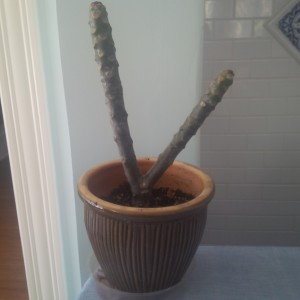Say the word “frangipani” to me and I think of a delicious almond pastry cream used in Italian tarts, cake and other delicacies. If you eat French pastries, you will know the same custard as “frangipane”. Either way, it is delicious and harbors the sweet smell of almonds.
Tropical plant fanciers know frangipani as a flowering plant of the genus Plumeria. The fragrant flowers used to be a major component of traditional Hawaiian leis. Orchids play that role more often now, but the plumeria or frangipani flower is still known for its beauty and compelling scent.
The flowers in question are golden-throated with five swirling petals apiece. Those deep throats allow pollination by sphinx moths, who are lured to them by the promise of delicious nectar. Sadly, the promise goes unfulfilled because the blooms are nectar-free. By the time the moths figure that out, they have done the job of transferring pollen.
Since last week’s Philadelphia Flower Show trip, I have been the proud owner of a plumeria plant. Right now it looks like a fat, wishbone-shaped asparagus spear protruding from a six inch pot of soil. That is because it is a dormant stem cutting, awaiting a moment of growth and glory that will start in about two months. I have admired plumeria for years, but have never grown one. The directions that accompanied the cutting suggest that growing this tropical shrub or small tree is the easiest thing in the world. I have heard that before.
There is no species information in the leaflet that came with my sunset-colored plumeria, but I suspect it is a variety of Plumeria rubra, the most commonly cultivated species. Though plumeria are almost universally identified with Hawaii, they are native from Mexico south to Panama. In Nicaragua, plumeria is the national flower. The numerous cultivated varieties feature flowers that can be white, yellow, pink, red, or a combination of those colors.
If you look closely at a four-inch-wide plumeria flower, you may notice a resemblance to common vinca, another member of the dogbane or Apocyaceae family. Dogbane blooms are often twisted in the bud, unfurling as they open. The stems contain a white, latex-like sap that may be irritating to some people. It is a good idea to wear gloves when pruning or snipping stems.
Plumeria or frangipani arrived in Hawaii as tourists in 1860. Unlike most tourists, they put down roots in the free-draining volcanic soil and became extremely popular. Hardy only in warm winter climates, Plumeria rubra can sprout into a 15 to 25 foot tall tree with an equal spread. Those of us in cold winter climates grow them in containers and the plants can be pruned to a smaller, more manageable size. This is especially necessary, because plumeria prefer an outdoor vacation in the late spring, summer and early fall.
Right now my unpromising-looking plumeria cutting is sitting in the sunniest window of my house. In accordance with the direction leaflet, I watered it when I stuck its flat end in the soil. I will water again when the soil dries out completely and not before. Easy as they allegedly are to grow, plumeria despise wet roots.
If all goes well, my plant will migrate to the back porch when outdoor temperatures are above 50 degrees Fahrenheit at night. A few months from now, probably when I have started to lose hope, the bare stalk will begin sprouting long, elliptical green leaves. I will up the watering timetable to twice a week and watch as the stalk grows and more leaves develop. When my plumeria returns to the house in the fall, it will most likely go dormant and lose those hard-won leaves. Patience is key with plumeria cuttings, because they do not bloom until the second year.
So what does a tropical plant have to do with Italian pastry? “Frangipani” comes from Latin root words that mean “broken bread”. The name was bestowed on a family of bakers who eventually became part of the Italian nobility. Allegedly, a sixteenth century member of the house of Frangipani created a perfume to be used on gloves. The sweet smell of the plumeria flowers reminded someone of Frangipani’s creation and the common name was coined. It is a long chain of links, but fragrance is the solder that holds it together.
If you have the requisite patience and want to try plumeria, there are numerous online suppliers. For a colorful selection of seeds and tip cuttings, try Brad’s Buds and Blooms, 605 Old Geneva Rd, Geneva, FL 32732 · (407) 349-9510; www.bradsbudsandblooms.com.

